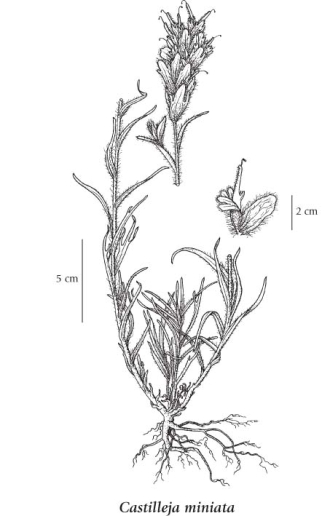Castilleja miniata Douglas ex Hook.
scarlet paintbrush (common red paintbrush)
Orobanchaceae (Broom-rape family)
(Previously in Scrophulariaceae)
Introduction to Vascular Plants
scarlet paintbrush (common red paintbrush)
Orobanchaceae (Broom-rape family)
(Previously in Scrophulariaceae)
Introduction to Vascular Plants
Species Information
General:
Perennial herb from a stout, scaly, somewhat woody stem-base; stems several and clustered or solitary on rhizomes, ascending to erect, 20-80 cm tall, simple or sometimes branched above, more or less smooth below, hairy above especially in the inflorescence.
Leaves:
Alternate, lance-linear to lanceolate, 3-10 cm long, entire, long-tapering to sharp-pointed tip, appressed-rough-hairy to nearly smooth.
Flowers:
Inflorescence a prominently bracted terminal spike, the bracts bright red or scarlet to orange, occasionally crimson or rarely yellow, lanceolate to oblong-egg-shaped, with 1 to 2 pairs of sharp lobes or teeth near the top or rarely entire, hairy and often sticky; corollas greenish, 20-40 mm long, 2-lipped, the upper lip beak-like, short-hairy, 9-20 mm long, 3/4 to about as long as the tube and 5 or more times the length of the thickened, 3-toothed lower lip; calyces red to scarlet, hairy, 15-30 mm long, deeply 2-lobed, these primary lobes again divided into 2 linear to lanceolate, sharp-pointed, 3- to 9-mm long segments; stamens 4.
Fruits:
Capsules, 9-12 mm long; seeds many, the seed-coats loose, net-veined.
Notes:
Appears to hybridize frequently with Castilleja unalaschcensis, and perhaps also C. hispida and C. rhexifolia.
Illustration

If more than one illustration is available for a species (e.g., separate illustrations were provided for two subspecies) then links to the separate images will be provided below. Note that individual subspecies or varietal illustrations are not always available.
Illustration Source: The Illustrated Flora of British Columbia
Ecology
Ecological Framework for Castilleja miniata
The table below shows the species-specific information calculated from
original data (BEC database) provided by the BC Ministry of Forests and Range.
(Updated August, 2013)
The table below shows the species-specific information calculated from
original data (BEC database) provided by the BC Ministry of Forests and Range.
(Updated August, 2013)
| Site Information |
Value / Class |
||
|
Avg |
Min |
Max |
|
| Elevation
(metres) |
1366 | 0 | 2563 |
| Slope
Gradient (%) |
24 | 0 | 230 |
|
Aspect (degrees) |
189 | 0 | 360 |
| Soil
Moisture Regime (SMR) [0 - very xeric; 4 - mesic; 8 - hydric] |
3 | 0 | 8 |
| Modal
Nutrient Regime
Class |
C | ||
| #
of field plots species was recorded in: |
1677 | ||
| Modal
BEC Zone Class |
ESSF | ||
|
All BEC Zones (# of stations/zone) species was recorded in |
AT(23), BAFA(32), BG(2), BWBS(74), CMA(6), CWH(23), ESSF(567), ICH(81), IDF(171), IMA(7), MH(12), MS(125), PP(9), SBPS(96), SBS(296), SWB(8) | ||
|
Source:
Klinkenberg 2013
|
|||
Habitat and Range
Wet to dry meadows, grassy slopes, fens, shrub-carrs, tidal marshes, clearings, roadsides, thickets and open forests from the lowland to subalpine zones; common throughout BC south of 57degreeN, infrequent northward and rare on the Queen Charlotte Islands; N to SE AK, E to W ON and S to ND, NM, AZ and CA.Status Information
| Scientific Name | Origin Status | Provincial Status | BC List (Red Blue List) | COSEWIC |
|---|---|---|---|---|
| Castilleja miniata var. dixonii | Native | S3S4 | Yellow | Not Listed |
| Castilleja miniata var. fulva | Native | S4 | Yellow | Not Listed |
| Castilleja miniata var. miniata | Native | S5 | Yellow | Not Listed |
BC Ministry of Environment: BC Species and Ecosystems Explorer.
Synonyms
Synonyms and Alternate Names:
Castilleja chrymactis Pennell
Castilleja hyetophila Pennell